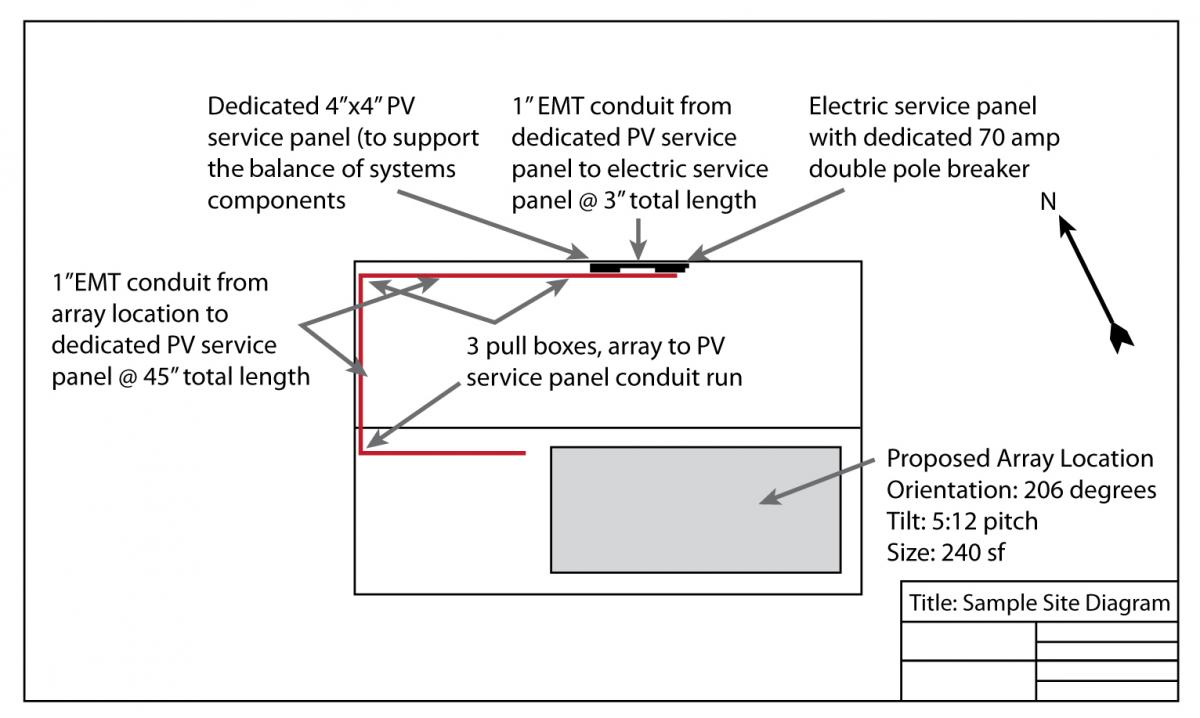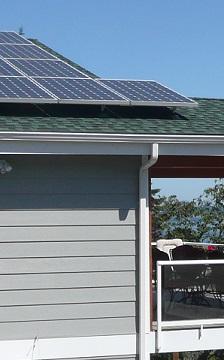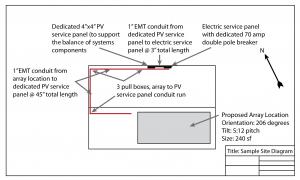Scope
Provide an architectural drawing and riser diagram for the homeowner showing the planned location for future photovoltaic and solar hot water system components. Space requirements and layout for photovoltaic and solar water heating system components should be taken into account early in the design process.
See the Compliance Tab for links to related codes and standards and voluntary federal energy-efficiency program requirements.
Description
A renewable energy-ready home (RERH) is one that is built with the wiring and plumbing conduit and other components in place to facilitate the future installation of solar photovoltaic (PV) panels and/or solar water heating panels. Some energy-efficiency programs, like the U.S. Department of Energy’s DOE Zero Energy Ready Home Program, require homes to be renewable-energy ready.
To meet the requirements of the DOE Zero Energy Ready Home program, provide an architectural drawing and riser diagram of RERH solar PV system components and solar hot water.
Develop architectural drawings and diagrams that summarize the installed system equipment (conduit, etc.) as detailed below (see Figure 1). These drawings should accurately represent the installed elements of the system and should be provided to the homeowner (likely to be used by future solar installer for obtaining a building permit). In addition, the homeowner should be provided with a one-line electrical riser diagram of the PV system components. The diagram should have sufficient detail to clearly identify:
- Configuration of the PV array
- Conduit size and type
- Electrical service panel location and dedicated circuit breaker slots
- Length of conduit from the designated array location to the designated inverter location
- Location and number of necessary pull boxes in line with each conduit run
- Length of conduit from the designated inverter location to the electrical service panel
- Location of the Balance-of-System (BOS) components
The drawings should also contain information about the PV array mounting system and identify the specifications for the major equipment including manufacturer, model and installation details.

When designing the system, always follow the recommendations of all local and national codes as well as manufacturer’s recommendations.
Success
Ensure adequate utility room early in the house design process to allow for ample space for solar photovoltaic (PV) and water heating system components. Confirm with local code officials early in the design process what steps are needed to guarantee that installation of PV panels will meet with local codes, homeowner's association covenants, and historic district regulations.
Protect the electrical and mechanical components of the PV system from bulk moisture, high temperatures, and direct sunlight. The utility room should be properly ventilated and maintain average indoor temperatures. Proper clearances and working spaces should also be maintained.
Climate
The DOE Zero Energy Ready Home PV-Ready Checklist (Revision 07) is required only under the following condition related to climate (See the Compliance Tab for other exceptions):
- Location, based on zip code, has at least 5 kWh/m2/day average daily solar radiation based on annual solar insolation using the PVWatts online tool. See map below.

Training
Compliance
More
More Info.
Access to some references may require purchase from the publisher. While we continually update our database, links may have changed since posting. Please contact our webmaster if you find broken links.
The following authors and organizations contributed to the content in this Guide.
Building Science Corporation, lead for the Building Science Consortium (BSC), a DOE Building America Research Team
Pacific Northwest National Laboratory
Sales
Solar Electric Ready Home = Solar Electric Ready Home

As solar photovoltaic (PV) panels have significantly come down in price, many homeowners are installing them to produce clean power and reduce their electric bills. Many more homeowners are likely to want this option for the future. Solar electric-ready homes make this possible with minimal to no disruption or cost penalty using simple no-cost/low-cost details and best practices integrated during construction. This includes ensuring adequate unshaded roof space for the PV panels, installing conduit from the attic to the electric service panel, securing documentation that the roof is designed to support the extra weight of the PV array, and providing adequate space near the electrical panel for balance of system components.

